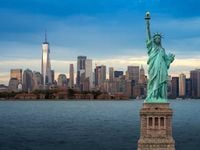On Saturday, April 19, 2025, thousands of protesters took to the streets in Washington and various other cities across the United States, voicing their opposition to President Donald Trump's policies regarding immigrant deportation, government layoffs, and the ongoing conflict in Gaza. The demonstrations, which were organized by various immigrant rights groups and activists, highlighted a growing discontent with the administration's approach to these critical issues.
Protesters gathered outside the White House, brandishing signs with slogans such as "The authority must be in the hands of the workers," "No to the monarchy," and "Stop arming Israel." These messages encapsulated a broader sentiment against perceived injustices and the administration's handling of immigration and foreign policy. Many demonstrators chanted in support of immigrants who have faced deportation under Trump's regime, expressing solidarity with federal employees who have been laid off and with universities threatened by funding cuts.
Among the crowd, Palestinian flags waved high as demonstrators donned traditional Palestinian keffiyehs, chanting, "Free Palestine!" This display of solidarity with Palestinians who have suffered in the ongoing conflict drew attention to the international dimensions of the protests. The demonstrators were particularly vocal about the casualties in Gaza, emphasizing their opposition to U.S. military support for Israel.
Since taking office in January, President Trump has enacted policies that have resulted in the dismissal of over 200,000 federal employees, a move that has raised concerns about the stability of government services and the impact on workers' livelihoods. Critics argue that these layoffs, combined with aggressive immigration enforcement, have created a climate of fear and uncertainty for many communities.
In addition to the protests, recent data has revealed a troubling trend for the U.S. tourism industry. According to a report from The Washington Post, the number of foreign tourists visiting the United States fell by 12% in March 2025 compared to the same month the previous year. This decline marks the first significant drop since the COVID-19 pandemic, raising alarms about the potential economic repercussions for the travel sector.
The report cites a sharp 28% decrease in visitors from Germany, while other regions also saw declines: Western Europe experienced a 17% drop, Central America 24%, and China 11%. Experts attribute this trend to growing concerns over entry procedures and the political climate in the U.S., which many international travelers find unwelcoming.
U.S. Secretary of State Marco Rubio has attempted to alleviate these fears, stating that travelers who are not participating in demonstrations supporting the Palestinian Hamas movement or inciting unrest at universities have nothing to fear. However, tourism expert Adam Sachs noted that the divisive rhetoric from the Trump administration has led many international travelers to avoid the United States altogether.
"The decision by international travelers to steer clear of the U.S. was anticipated," Sachs told The Washington Post. "The current political climate and the administration's policies have created an atmosphere of uncertainty that many find uninviting." He emphasized that this trend could lead to significant losses for the U.S. tourism industry, potentially amounting to billions of dollars.
While the total figures for tourist arrivals have yet to be fully disclosed, it is evident that the decline in visitors is a growing concern. Traditionally, the majority of tourists to the U.S. come from countries such as France, Germany, Italy, Spain, the United Kingdom, Japan, South Korea, China, and India. The drop in numbers from these key markets could have lasting implications for the economy.
The protests and the declining tourism statistics reflect a broader narrative of discontent with the current administration's policies, both domestically and internationally. As demonstrators continue to rally against Trump's immigration and foreign policies, the economic impact of these policies is becoming increasingly evident.
In light of these developments, it remains to be seen how the administration will respond to the growing unrest among citizens and the international community. The coming weeks may prove pivotal as the government navigates the complexities of public sentiment and economic realities.
As the protests unfold and tourism numbers continue to plummet, one thing is clear: the stakes are high, and the implications of these events will resonate far beyond the immediate political landscape.




